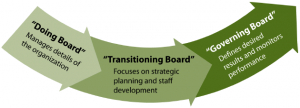In this article, we’re going to highlight two important decisions that can throw a Board into turmoil – along with some tips on how to navigate them.
 The life of a non-profit Board typically follows a somewhat predictable rhythm where Board meetings consist of reports from committees and staff, along with discussions about fundraising goals, advocacy activities, and Board outreach efforts. These periods of normalcy can change, however, to periods of acute stress and anxiety when the Board is called on to make crucial decisions. (Download the PDF)
The life of a non-profit Board typically follows a somewhat predictable rhythm where Board meetings consist of reports from committees and staff, along with discussions about fundraising goals, advocacy activities, and Board outreach efforts. These periods of normalcy can change, however, to periods of acute stress and anxiety when the Board is called on to make crucial decisions. (Download the PDF)
The first decision, of course, is the recruitment and hiring of a new chief executive.
Whether it’s an unexpected departure or the planned retirement of your chief executive, it will most likely expose one or more of the following issues that may not have surfaced previously:
- How do we collectively, as a group, understand and define the role of the CEO?
- To what extent is the organization led by the Board versus led by the CEO?
- Are we aligned around the ways in which the Board guides and directs the organization versus the CEO?
- Are we looking for a change or to maintain the current role as defined by the departing CEO?
- What is our process for vetting and winnowing candidates?
- What decisions are delegated to the search committee? A search consultant?
- How much consultation with the full Board needs to occur at each step along the path to identifying the final candidates?
- What are the ground rules around protecting confidentiality?
- Who will be able to see all of the applicant candidates’ names, resumes, and background information?
- What are the rules – and how do we hold one another accountable to those rules?
- Finally, what are our salary expectations for the new CEO?
- Are they in line with the market?
- What are we prepared to offer?
In our experience, it’s best to define the decisions that will need to be made up front. You can build understanding and consensus around who will make each decision – and how much consultation with the Board is needed at each step. The clearer the expectations, the less likelihood for problems later in the process.
The second crucial decision is changing the Board’s composition.
For example, many non-profit Boards are focused today on increasing diversity, equity, and inclusion. This is a good goal. But how quickly does the Board wants to transform itself? Is it willing to ask current members to leave to make room for new members? What’s the right mix of new vs. old members? Related discussions include:
- Who are the communities we serve and how, in an ideal world, would our Board be composed to reflect them?
- Do we view our Board members as ambassadors to specific constituencies? If so, what does that entail?
- Do Board members agree with those expectations?
- What other Board member expectations might need flexibility in order to achieve this goal e.g. fund-raising expectations?
- How do we assure our Board leadership embraces these values and, at the same time, is provided sufficient authority to take action on the Board’s behalf?
- What are the “guardrails” around that authority?
Developing a shared vision for transforming the Board takes time and patience. An expert in facilitating change may be an important factor in success – and assuring the decision to transform doesn’t result in bitter feelings down the road.
Next Post: Tips for Non-Profits to Manage Complex, Multi-Funder Projects
Board Development Resources
This post was originally published at the Sacramento Business Journal.
Leading Resources, Inc. is a Sacramento Board Governance Consulting firm that develops leaders and leading organizations. Subscribe to our leadership development newsletter to download the PDF – “The 6 Trust-Building Habits of Leaders” to learn more about how to build trust with your team.
 Client Member Area
Client Member Area 
